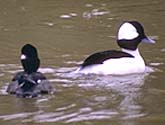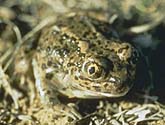
Home |
About Us |
How to Participate |
Biodiversity Modules |
Projects |
Maps |
News |
Resources

Home |
About Us |
How to Participate |
Biodiversity Modules |
Projects |
Maps |
News |
Resources
|
Definition of "Wetlands" - General Code 500: Vegetated areas where plants are rooted in water or water saturated soil or that regularly tolerate flooding for extensive time periods. |
Wetlands: Vernal Pond (540)


| |
| Descriptive Habitat Code: This wetland (5) is a vernal pond (2)
surrounded by many vegetation types (0).
Vernal pools are wetlands which dry up part of the year. | |
| Photo: Tim Knight | |
 American wigeon Anas americana Code: ANAAM Photo: RA | Distribution and
Habitat: It is distributed across North America from Alaska southward to Costa Rica Diet: Interesting fact: |
 Bufflehead Bucephala albeola Code: BUAL Photo: RA | Distribution
and Habitat: It is found in both freshwater lakes and wetlands as well as salt marshes and inshore marine areas. Diet: Interesting
fact: |
 Ensatina Ensatina eschsholtzi Code:ENES Photo: WDFW |
Distribution and Habitat: It is found under bark, logs and rocks in coniferous and deciduous forests; both in open and wooded settings. Diet: Interesting fact: |
 Great Basin spadefoot toad Spea intermontana Code: SPIN Photo: WDFW |
Distribution and Habitat: It is found in semi-arid shrublands, dry woodlands, and other areas where it lives in the underground burrows of gophers, etc. Diet: Interesting fact: |
 Green heron Butorides striatus Code: BUST Photo: RA | Distribution and
Habitat: The green heron is found in secluded wetlands, wooded sloughs, and along slow-moving water in ditches. Diet: Interesting fact: |
 Mallard Anas platyrhynchos Code: ANPL |
Distribution and Habitat: It is found in wetlands, lakes, ponds, rivers, estuaries and coastal marine areas. Diet: Interesting fact: |
 Pacific tree frog Hyla regilla Code:PSRE Photo: WDFW |
Distribution and Habitat: It is found throughout the Pacific Northwest, never too far from small ponds. Diet: Interesting fact: |
 Painted turtle Chrysemys picta Code: CHPI Photo: WDFW |
Distribution and Habitat: It is found in wetlands, lakes, ponds and rivers. Diet: Interesting fact: |
 Raccoon Procyon lotor Code: PRLO Photo: KMD |
Distribution and Habitat: It is native throughout most of the United States and southern Canada, but has also been introduced into Europe and Asia. It is a common inhabitant of agricultural and residential areas. Diet:
Interesting fact: |
 Red-legged frog Rama aurora Code: RAAU Photo: BL | Distribution
and Habitat: The red-legged frog is found in moist grasslands, forests, woodlands, wetlands, stream banks, and in or near other areas with standing water. Diet: Interesting
fact: |
 Red-winged blackbird Agelaius phoeniceus Code: AGPH Photo: Natures Pics |
Distribution and Habitat: It is found in wetland areas. Diet: Interesting fact: |
 Van Dyke's salamander Plethodon vandykei Code: PLVA Photo: WDFW |
Distribution and Habitat: It is found under rocks and logs located near lakes, streams, creeks, rivers, wetlands and areas of saturated soil. Diet: Interesting fact: |
Home |
About Us |
How to Participate |
Biodiversity Modules |
Projects |
Maps |
News |
Resources